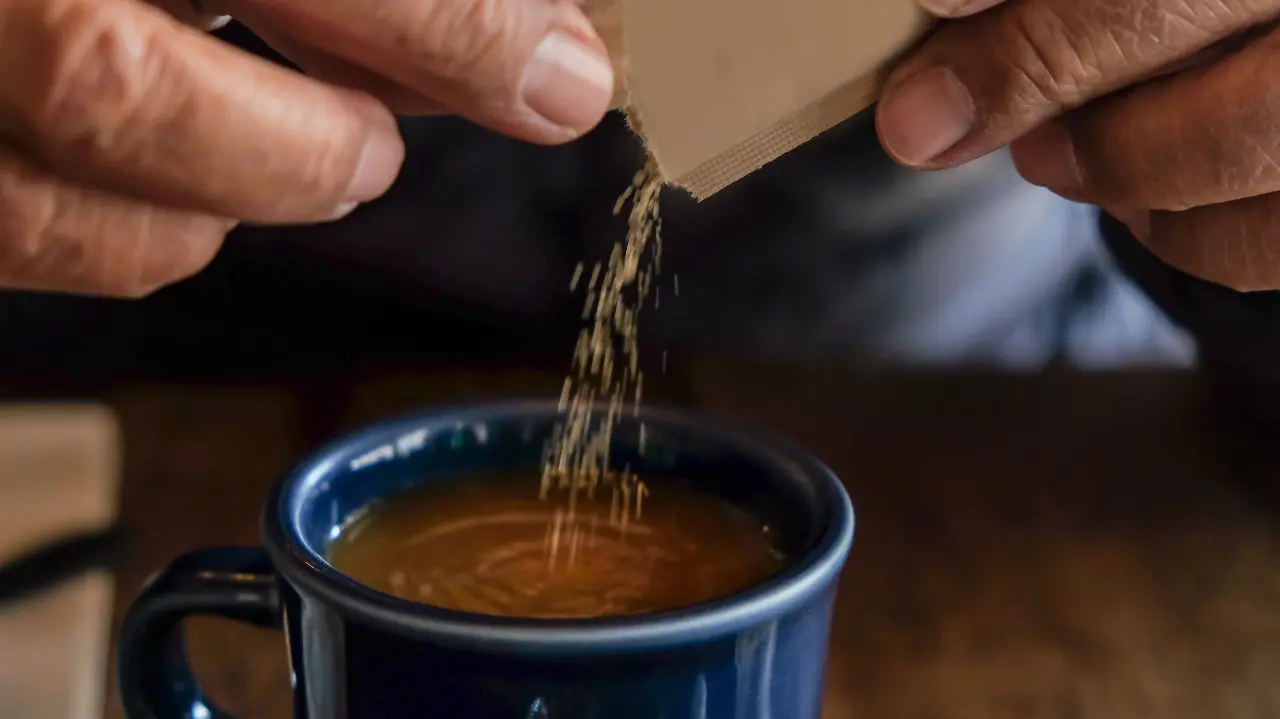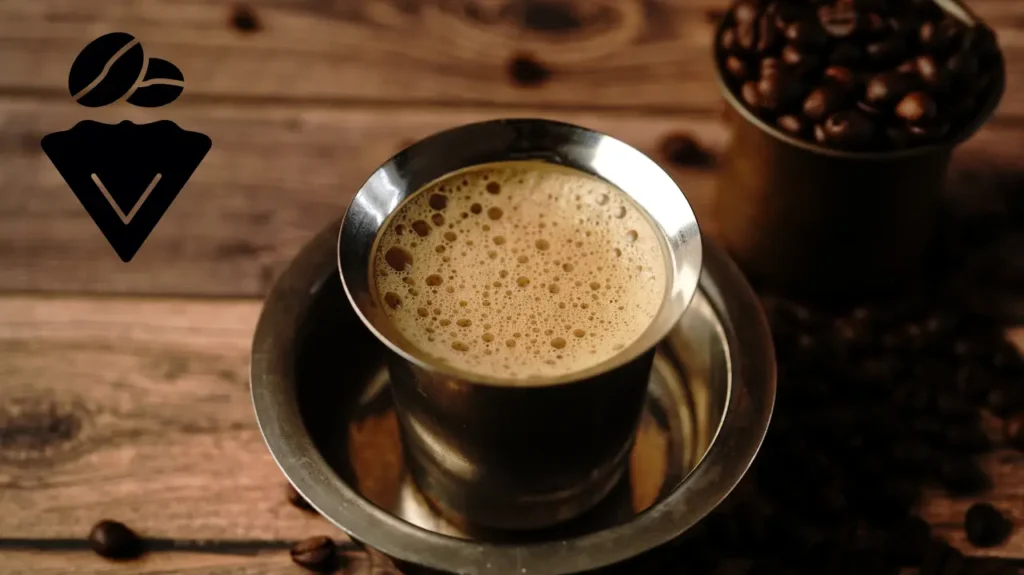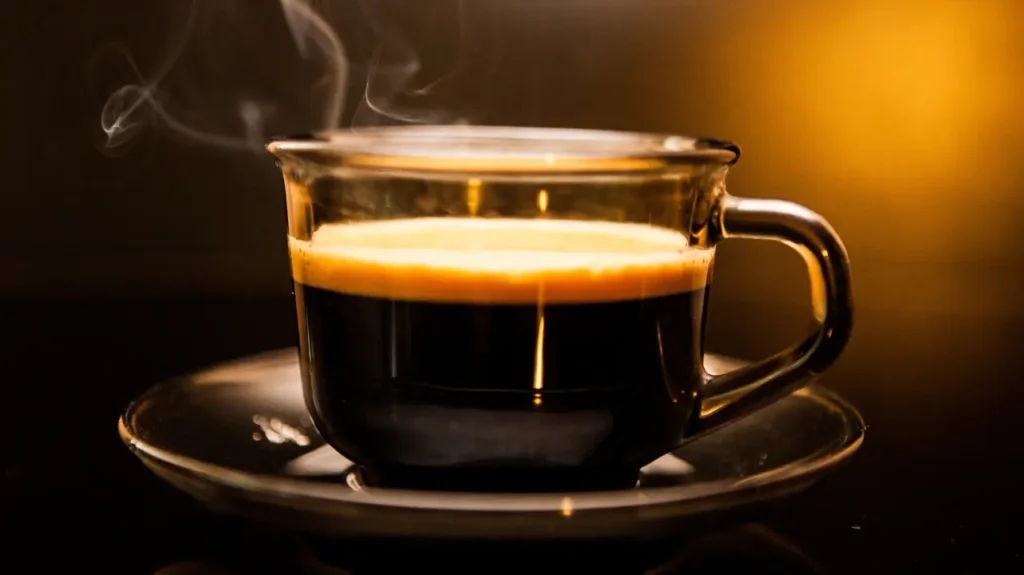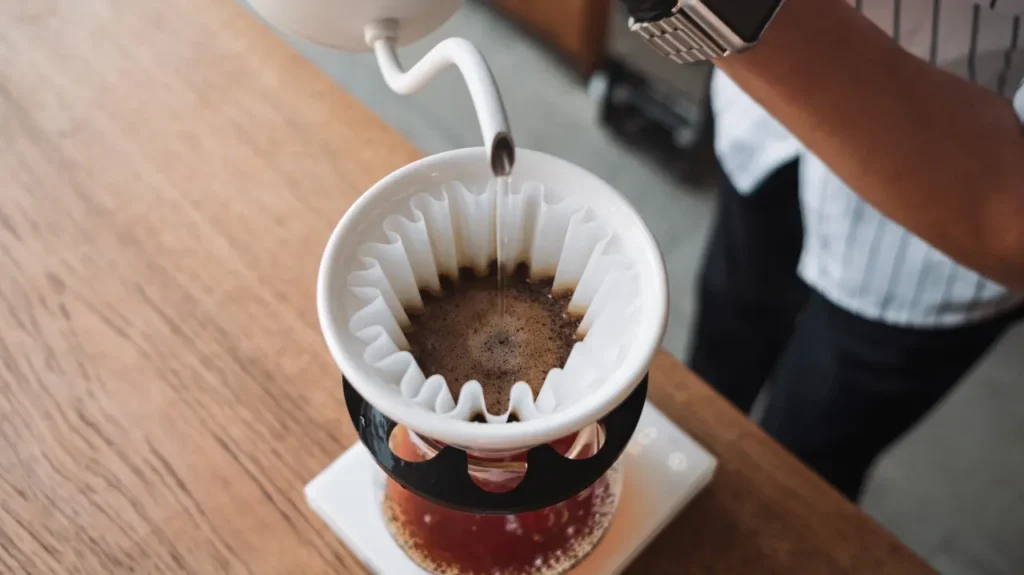Coffee isn’t just a drink; it’s your daily ritual. And that half-empty bag of brown sugar sitting in your kitchen? It might be the upgrade your brew needs.
Let’s chase: Can you put brown sugar in coffee? Absolutely. But why stop there? I’ve spent years geeking over coffee, testing beans, brewing methods, and every sweetener under the sun.
Brown sugar isn’t just a swap for white sugar. It’s a flavour game-changer.
This isn’t a maybe. It’s a try it now. We’ll discuss how brown sugar dances with coffee’s bitterness, what baristas think, and whether “healthier” is hype.
The Appeal of Brown Sugar in Coffee
Brown sugar isn’t just a sweetener; it’s a flavour alchemist. While white sugar dissolves into bland sweetness, brown sugar weaves caramel, toffee, and a whisper of smokiness into every sip.
The secret? Molasses is the sticky, mineral-rich syrup retained during sugar refining. This isn’t just about sweetness; it’s about harmony.
The molasses tempers coffee’s sharp acidity and bitterness, creating a rounder, more nuanced profile. Imagine a velvety latte with caramel undertones or a cold brew that tastes like liquid dessert.
See if mushroom coffee is acidic for those curious about coffee’s acidity in other contexts.
But there’s more to the story. Brown sugar comes in two faces: light (mild, with 3-4% molasses) and dark (bold, 6-8% molasses).
Light brown sugar dances with floral, single-origin beans, amplifying their delicate notes. Dark brown sugar partners with espresso or chocolatey blends, adding depth without masking complexity.
Chemically, molasses is a pH balancer. Its alkaline nature softens coffee’s natural acids, making it gentler on sensitive stomachs.
Nutritionally, it offers trace minerals like iron and calcium, trivial amounts, but a perk over empty-calorie white sugar.
How does coffee interact with dental work? Learn more about how you can drink coffee after a filling.
Globally, brown sugar bridges traditions. In Southeast Asia, it’s stirred into kopi susu for a smoky sweetness.
In Mexico, café de olla simmers piloncillo (unrefined brown sugar) with cinnamon for a spiced brew.
Practical perks? Its moisture content melts seamlessly into hot coffee, but craft a brown sugar syrup (1:1 sugar-water, simmered) for iced drinks.
It blends instantly, avoiding gritty sinks to the bottom.
Yet balance is key. Overdo it, and molasses dominate. Start with ½ tsp per cup, adjusting to taste. Pair light roasts with light brown sugar and dark roasts with dark.
For the eco-minded, brown sugar is less processed than white, a small win for sustainability.
What Do Coffee Experts Think?
Coffee professionals aren’t just tolerating brown sugar; they’re championing it. In speciality coffee circles, brown sugar is seen as a tool for flavour layering, not just sweetening.
With its delicate molasses, light brown sugar is a barista favourite for pour-overs and single-origin brews.
“It’s like adding a soft backbeat to a song; it supports the show without stealing it,” says Alex, a San Francisco barista.
Light brown sugar can highlight those nuances for Nordic light roasts with floral or berry notes, whereas white sugar flattens them.
Dark brown sugar, however, has its devotees. Roasters like Sarah note its synergy with natural-processed beans: “The raisin and dried fruit notes in Ethiopian coffees?
Dark brown sugar amplifies them, creating a dessert-like depth.” It’s also a secret weapon in espresso-based drinks; try a brown sugar cortado where the sugar’s richness mirrors the milk’s creaminess.
Beyond the basics, experts geek out on niche sugars:
- Demerara: Its large, glittery crystals dissolve slowly, ideal for iced coffee or cold brew. The gradual sweetness release keeps each sip balanced.
- Muscovado: Unrefined and moist, it’s a hit in café Cubano or Turkish coffee, where its almost smoky intensity stands up to high heat and strong brews.
But there’s a caveat. “Sugar isn’t a bandage for bad beans,” warns James Hoffmann, World Barista Champion.
“If your coffee tastes bitter or ashy, fix the grind or water first. Sugar should enhance, not rescue.”
Texture matters, too. Coffee scientist Dr Samo Smrke points out that brown sugar’s hygroscopic nature (it retains moisture) affects extraction.
It can slightly soften harsh acids in lighter roasts, but in darker roasts, it may mute already subtle acidity.
Globally, traditions validate this:
- In Japan, kohi with kokuto (Okinawan black sugar) is a winter staple, paired with dark, earthy Sumatran beans.
- In Italy, some espresso purists stir in zucchero di canna (cane sugar) for a caramelized crema boost.
Health Implications
The health debate around brown sugar hinges on nuance. Yes, brown sugar contains trace minerals, calcium (8mg per tsp), iron (0.1mg), and potassium (11mg), thanks to molasses.
But to meet your daily iron needs, you’d need 50 teaspoons, which drowns your coffee in 800+ calories.
Nutritionally, it’s a wash: sugars pack 16 calories and 4g carbs per teaspoon.
The glycemic index (GI) tells a similar story. Brown sugar’s GI is ~64 vs. white sugar’s 65, a negligible difference.
However, pairing brown sugar with coffee’s chlorogenic acids (antioxidants) may slightly blunt blood sugar spikes compared to sugary sodas.
Still, people with diabetes should treat both sugars cautiously.
Where brown sugar wins is in perception. Its rich flavour often leads people to use less, ½ tsp instead of a whole tsp of white sugar, subtly cutting calories.
The molasses also adds antioxidants like polyphenols, albeit in microscopic amounts. For context, you’d need 100g of brown sugar to match the antioxidants in one blueberry.
For health-conscious sippers, alternatives exist:
- Raw honey offers enzymes and antioxidants but higher fructose.
- Maple syrup has zinc and manganese but costs more.
- Stevia is zero-calorie but can leave a liquorice-like aftertaste in coffee.
A 2021 Journal of Food Science study found no significant metabolic difference between brown and white sugar in small doses.
The takeaway?
Brown sugar’s edge is flavour, not health. Use it as a conscious indulgence, stirred into a weekend latte, not gulped daily.
Types of Brown Sugar and Their Impact on Coffee
Not all brown sugars are created equal; each type brings a unique personality to your cup. Below, we explain how molasses content, texture, and origin shape coffee compatibility.
| Type | Molasses Content | Flavor Profile | Best For |
| Light Brown Sugar | Low (3.5%) | Mild, buttery, subtle caramel | Everyday coffee, light/medium roasts, lattes |
| Dark Brown Sugar | High (6.5%) | Rich, deep molasses, smoky | Bold espresso, dark roasts, mochas |
| Demerara Sugar | Subtle | Toasty, large crystals, mild | Cold brew, iced coffee (adds texture) |
| Muscovado Sugar | Very High | Intense, earthy, almost licorice | French press, Turkish coffee, chicory blends |
For tips on crafting the perfect cold brew, explore how much caffeine is in Vietnamese coffee.
What the Table Doesn’t Tell You
Light Brown Sugar is the crowd-pleaser. Its fine, sandy texture melts seamlessly into hot coffee, making it ideal for quick dissolution in americanos or cappuccinos.
Popular in Scandinavia, it’s paired with light roasts to accentuate floral notes without overshadowing them.
Dark Brown Sugar hails from the Caribbean, where its boldness stands up to high-acidity African beans. Its slight acidity (pH 5.5 vs. white sugar’s 6.0) can balance bitter dark roasts.
Pro tip: Dissolve it in a splash of hot water first for iced coffee to avoid graininess.
Demerara Sugar, originally from Guyana, isn’t technically brown sugar; it’s raw cane sugar with a thin molasses coating. Its crunch survives cold brew steeping, adding a subtle textural thrill.
Try it in the nitro cold brew for a caramelized top note.
Muscovado Sugar is unrefined and hygroscopic (retains moisture), which means it clumps, but that’s good. Its sticky texture clings to espresso crema, slowly releasing sweetness.
Popular in Filipino cape, it’s stirred into robust Barako coffee for a molasses-laced kick.
Unexpected Pairings
For a bright Ethiopian Yirgacheffe, light brown sugar whispers floral highs and lemon zest into the cup.
Sumatra Mandheling’s earthy, cocoa soul finds its match in dark brown sugar, deepening its rustic charm.
Demerara’s toasty crunch elevates Brazilian Santos’ nutty, mellow vibe. And muscovado? Cuban espresso’s shadow is smoky, intense, and unapologetically bold, mirroring tobacco-rich depths.
Texture & Brew Hacks
French press fans reach for muscovado; its gritty grains sink past the mesh, dodging sludge and craving caramel-kissed espresso.
Sprinkle dark brown sugar on the puck before tamping; it melts into a velvety crema.
Aeropress adventurers toss in demerara; its crystals survive the plunge, leaving a satisfying crunch at the bottom of your brew.
Can You Put Brown Sugar in Coffee? Practical Tips
Adding brown sugar to coffee is an art of balance and technique. Here’s how to master it.
Dissolve Like a Pro
Brown sugar’s moisture makes it clump. Stir it into hot (not boiling) coffee using a spoon or milk frother.
For iced coffee, dissolve it in a splash of hot water first to avoid gritty sludge.
Start Small, Taste Often
Begin with ½ tsp per 6oz cup. Light brown sugar’s sweetness creeps up; add incrementally to avoid overpowering delicate pour-overs.
Dark brown sugar? 1 tsp max for espresso.
Milk’s Best Friend
Brown sugar’s caramel notes amplify the creaminess of milk. Try it in oat milk lattes to enhance oat’s natural sweetness, or whisk it into Dalgona coffee foam for a toffee-like crown.
Brew-Specific Hacks
Add dark brown sugar before pouring water for the French press, and melt with oils during steeping. For seamless integration, cold brew lovers should use demerara syrup (1:1 sugar water).
Moka pot users sprinkle muscovado on the coffee grounds pre-brew for a molasses-infused shot.
Master your grind for these methods with how long to grind coffee beans.
Syrup Secrets
Simmer 1 cup brown sugar + 1 cup water + a cinnamon stick: strain and bottle. Use in iced coffees, cocktails, or drizzle over latte art.
Texture Tricks
In an Aeropress, layer demerara crystals at the bottom of the chamber, pressure extracts their crunch. For Turkish coffee, stir muscovado into the cezve pre-boil for a silky, unfiltered brew.
Storage Savvy
To prevent hardening, keep brown sugar in an airtight jar with a terra cotta disc or marshmallow. Revive rock-hard sugar: microwave with a damp paper towel for 20 seconds.
Pair with Salt
A pinch of sea salt counteracts bitterness and heightens brown sugar’s caramel depth, espresso’s best-kept secret.
Acidity Adjustments
Are light roasts too bright? Dark brown sugar’s molasses softens acidity. Are dark roasts too flat? Light brown sugar adds spark without sweetness overload.
Beyond the Mug
Brush brown sugar syrup on espresso martini glasses for a caramel rim or mix into coffee ice cream bases for a deeper flavour profile.
Delicious Recipes to Try
Brown sugar isn’t just a sweetener; it’s a co-star in your coffee creations.
These recipes celebrate its versatility, from sunup sips to late-night treats, each designed to highlight molasses’ magic without overshadowing your brew’s character.
1. Brown Sugar Iced Coffee
Ingredients: Strong brewed coffee (cooled), brown sugar syrup (or 1-2 tsp brown sugar dissolved in hot water), milk (dairy or oat), ice cubes, cinnamon (optional).
Instructions: Brew a bold coffee and try a medium-dark roast for depth. Cool it rapidly by pouring over ice (discard melted ice afterwards).
Stir in brown sugar syrup (simmer 1:1 sugar water with a vanilla pod for bonus flavour). Add milk until the mix turns caramel-hued.
Serve over fresh ice, dusted with cinnamon. Pro twist: Freeze coffee into ice cubes to prevent dilution.
For more iced coffee inspiration, try how to make Nespresso iced coffee.
2. Brown Sugar Latte
Ingredients: Espresso (1-2 shots), dark brown sugar (1 tsp), steamed milk (whole or barista-style oat), cinnamon, nutmeg.
Instructions: Pull a ristretto shot for extra sweetness. Dissolve dark brown sugar in the espresso, and its molasses cling to the crema; steam milk to 150°F (65°C) for silky foam.
Pour slowly, holding back the foam with a spoon, then top it with a foam cap.
Garnish with cinnamon-nutmeg swirl; pro twist: Caramelize sugar on the espresso puck pre-extraction for a burnt-sugar note.
3. Brown Sugar Cold Brew
Ingredients: Cold brew concentrate, muscovado sugar (1-2 tsp), ice, heavy cream (optional), orange zest.
Instructions: Stir muscovado into a cold brew; its grit dissolves slowly, spreading sweetness. Pour over ice, and float a splash of heavy cream for contrast.
Zest an orange peel over the top; the citrus oils cut through molasses richness. Pro twist: Infuse cold brew with a star anise pod overnight for a spiced edge.
4. Brown Sugar Dalgona Coffee
Ingredients: Instant coffee (2 tbsp), dark brown sugar (2 tbsp), hot water (2 tbsp), milk (chilled), ice.
Instructions: Whip coffee, sugar, and water until stiff peaks form; brown sugar’s moisture speeds up frothing. Fill a glass with milk and ice, dollop foam on top.
Stir gently to marble; pro twist: Swap milk for coconut water for a tropical spin.
5. Brown Sugar Café de Olla
Ingredients: Coarse-ground coffee, dark brown sugar (2 tbsp), cinnamon stick, clove, water.
Instructions: Simmer sugar, spices, and water until syrupy. Add coffee and steep for 5 minutes. Strain into mugs, traditional clay cups amplify earthiness.
Pro twist: Add 70% dark chocolate square while simmering for a Mexican mocha vibe.
Serving Wisdom:
- Temperature Matters: Dissolve brown sugar in hot liquids first for even sweetness; cold brews need syrups.
- Spice Pairings: Cardamom + light brown sugar = floral lift. Smoked sea salt + dark brown sugar = savoury-sweet kick.
- Glassware: Serve iced versions in mason jars with copper straws, and molasses reacts subtly with metal, enhancing aroma.
Beyond the Cup:
Drizzle leftover brown sugar syrup over coffee ice cream, or brush it on bacon before baking for a sweet-savoury coffee brunch side.
The Science Behind the Pairing
Coffee and brown sugar aren’t just a tasty duo but biochemical ballets. Here’s how chemistry and sensory science explain their harmony.
Acid vs. Alkaline
Coffee’s acidity (pH 4.8–5.1) comes from chlorogenic acids, which can trigger bitterness receptors on the tongue.
Brown sugar’s molasses contains alkaline minerals like calcium and potassium, nudging the brew’s pH closer to neutral (6.5–7.0).
This shift doesn’t erase acidity but softens its sharp edges, making bright coffees smoother and dark roasts rounder.
Think of it as a chemical “bridge” between coffee’s bite and your palate’s comfort.
Flavor Synergy
When coffee’s 800+ aromatic compounds meet molasses’ 50+ volatiles, magic happens. Molasses contributes:
- Furfural: A caramel-like compound that amplifies coffee’s roasted notes.
- Guaiacol: Smoky molecules that echo dark roasts’ charred sweetness.
- Vanillin: Subtle vanilla undertones that lift floral or fruity single-origin beans.
These compounds bind to coffee’s existing aromas, creating layered flavours white sugar can’t match. Light roasts gain depth; dark roasts gain complexity.
Thermal Dynamics
Adding brown sugar to hot coffee (195–205°F / 90–96°C) triggers caramelization.
The Maillard reaction, the same process that browns bread, transforms molasses’ sugars and amino acids into new flavour molecules.
This is why a hot latte with brown sugar tastes richer than one sweetened post-brew.
Sensory Perception
Bitterness and sweetness receptors on the tongue are neighbours.
Brown sugar’s sucrose and fructose molecules bind to sweetness receptors, partially blocking bitterness signals, a phenomenon called binary taste interaction.
Molasses’ earthy tones distract the brain from perceiving harshness, making even over-extracted brews palatable.
Texture and Viscosity
Molasses’ thick, hygroscopic nature adds viscosity. Even dissolved, it leaves a velvety coating on the tongue, mimicking the mouthfeel of cream.
This “fake fat” effect makes black coffee with brown sugar feel indulgent, even without dairy.
Cultural Chemistry
Ancient practices like Mexico’s café de olla (coffee with piloncillo) unknowingly exploited this science.
The iron in unrefined sugar binds with coffee tannins, reducing astringency, a trick modern baristas now use intentionally.
Comparing Brown Sugar to Other Sweeteners
Choosing a sweetener isn’t just about calories; it’s about chemistry, culture, and how flavours tango in your cup.
Here’s how brown sugar holds its ground against popular alternatives.
White Sugar
White sugar, refined to 99.8% sucrose, dissolves swiftly but leaves no fingerprint. Its neutrality preserves coffee’s origin traits, which makes it ideal for cupping sessions where terroir is king.
Yet, its high glycemic index (65) spikes blood sugar faster than brown sugar’s molasses-buffered 64.
Without minerals or acids to interact, it amplifies coffee’s inherent bitterness for some palates. Think of it as a mirror: it reflects, never enhances.
Honey
Honey’s 200+ compounds, enzymes, pollen, and floral esters make each varietal unique. Clover honey softens acidic African coffees, while buckwheat’s maltiness clashes with nutty Brazilian beans.
But heat destroys its delicate enzymes, turning nuanced sweetness into flat syrup. Raw honey’s granulated texture also resists dissolving in iced coffee, creating uneven sips.
For traditionalists, Yemeni qishr pairs coffee husks with honey, a ritual where fermentation mellows both.
Discover if you can put kefir in coffee for another creamy twist.
Maple Syrup
Maple syrup’s 54 antioxidants, including anti-inflammatory quebecol, add depth beyond sweetness.
Grade B’s robust, almost smoky profile elevates chocolatey Guatemalan beans but overpowers delicate-washed Ethiopians.
Its viscosity, thicker than honey, coats the tongue, mimicking the creaminess of black coffee.
Yet, its distinctness polarizes: love it in a Canadian maple latte, hate it in a citrusy Kenyan pour-over.
Stevia
Stevia’s glycosides, 300x sweeter than sucrose, hijack bitterness receptors, a double-edged sword.
At the same time, it dodges blood sugar spikes, and its liquorice-like aftertaste clashes with coffee’s inherent bitterness, amplifying harshness in dark roasts.
Modern hybrids (mixed with erythritol) mask this, but purists argue they mute coffee’s subtler notes. People with diabetes swear by it; flavour chasers flee.
Brown Sugar
Brown sugar’s edge? Molasses, a flavour catalyst. Its 6% moisture slows sucrose dissolution, gradually releasing sweetness and melding with coffee oils.
Light brown sugar’s pH of 5.5 gently buffers high-acid Kenyan brews, while dark’s pH of 6.0 tempers Sumatra’s earthiness.
Unlike maple or honey, it doesn’t compete; it collaborates, caramelizing under heat to amplify coffee’s roasted DNA.
Coffee Expert’s Final Thoughts
Coffee is more than a beverage; it’s a dialogue between bean, brewer, and drinker. Over years of cupping, roasting, and brewing, I’ve learned this: the “perfect” cup doesn’t exist. It’s a myth.
What exists is your perfect cup, a fleeting alchemy of mood, method, and moment. Brown sugar isn’t a universal fix but a key to doors you might not have opened yet.
Consider this: every coffee-growing region has its sweetener symbiosis. In Cuba, café Cubano marries espresso with a caramelized brown sugar crust.
In Thailand, oliang floats condensed milk and palm sugar over icy brews. These traditions weren’t born from trends but generations asking, “How can we make this bean sing?”
Your kitchen is your lab: your spoon, the conductor’s baton.
For off-grid brewing ideas, see how to make coffee without electricity.
Brown sugar’s role? It’s a bridge between acidity and sweetness, tradition and rebellion. Try it in a washed Ethiopian pour-over, and watch floral jasmine notes bloom.
Stir it into a smoky Sumatran French press, and taste the earth soften. But also know when to step back.
A pristine Geisha or a delicate Yemeni might demand solitude; their stories are told best unsweetened.
Here’s the truth no one tells you: coffee’s magic lies in its contradictions. It’s both ritual and rebellion, science and art. Brown sugar leans into that paradox.
It’s humble yet transformative. Accessible, yet mysterious.
So, as you stand before your brewer tomorrow morning, ask: “What does this coffee need?” Maybe it’s a whisper of light brown sugar.
Maybe silence. The beans won’t judge. They’ve weathered monsoons, crossed oceans, and survived roasters. They’re ready for your curiosity.
And if you “fail”? You didn’t. You discovered a path not to take. In coffee, as in life, the missteps are maps.
Conclusion
Yes, brown sugar belongs in your coffee, and it might just become your new secret weapon. With its caramel depth and acidity-balancing magic, it turns ordinary brews into nuanced experiences.
Light brown sugar whispers sweetness into delicate pour-overs, while dark varieties transform espresso into liquid dessert.
Start small: a half-teaspoon in your morning cup. Notice how molasses tease out hidden notes, maybe blueberry in that Ethiopian or cocoa in your cold brew.
Hate it? No harm done. Love it? Explore muscovado in Turkish coffee or demerara syrup over ice.
Coffee’s beauty lies in its adaptability. Brown sugar isn’t a rule; it’s a toolkit. Your mug, your masterpiece. Stir, sip, and savour the upgrade.




